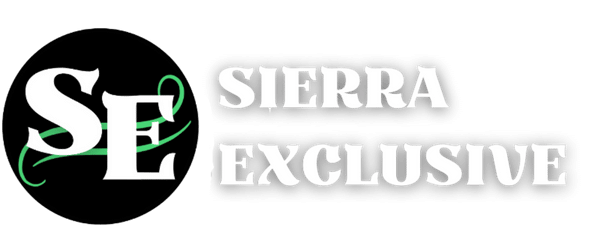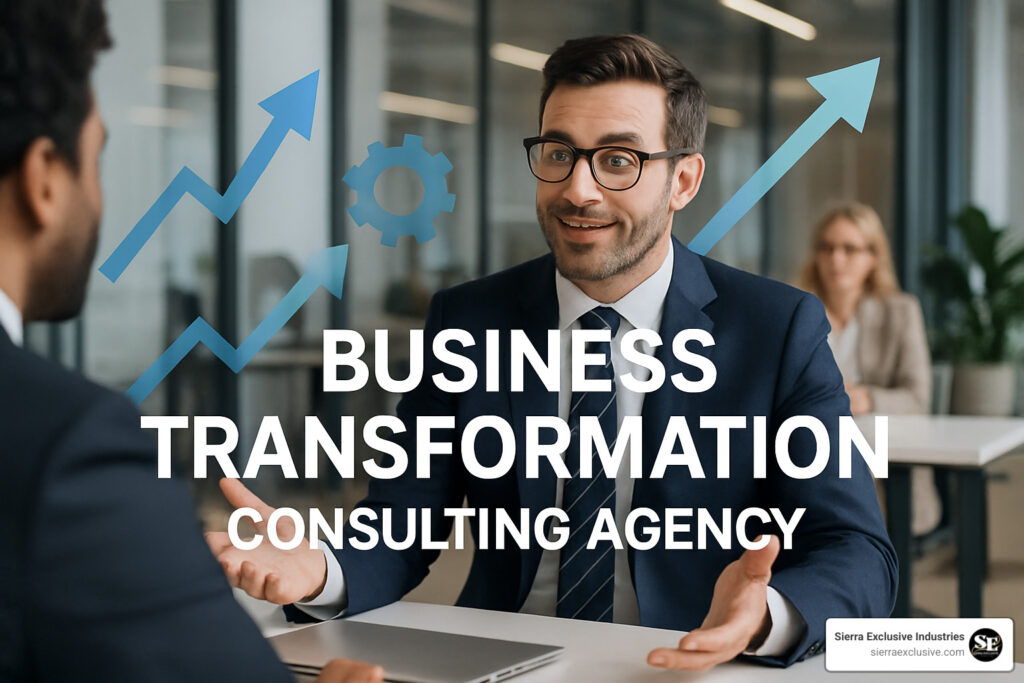Why Business Change Consulting Agencies Are Critical for Modern Success
A business change consulting agency helps companies steer large-scale organizational change to open up growth, improve performance, and adapt quickly to market disruption. These specialized firms combine strategic vision with hands-on execution to deliver measurable results across operations, technology, culture, and financial performance.
What Business Change Consulting Agencies Do:
- Strategic Planning – Develop comprehensive change roadmaps aligned with business goals
- Operational Excellence – Redesign processes, supply chains, and organizational structures
- Digital Change – Implement technology solutions and AI-powered automation
- Culture Change – Drive employee engagement and leadership alignment
- Performance Acceleration – Deliver measurable improvements in revenue, costs, and efficiency
The need for change has never been greater. Research shows that 75% of business changes fail to deliver long-term impact, while only 7% of companies fully implement their digital changes. Yet organizations that successfully execute change programs achieve 15% higher total shareholder returns compared with industry benchmarks.
Common triggers include market disruption, competitive pressure, declining performance, regulatory changes, or growth opportunities. Whether reactive (responding to crisis) or proactive (staying ahead of trends), change requires both bold vision and disciplined execution.
As Seth Gillen, I’ve spent over 10 years scaling companies to $10M+ revenue and understand how a business change consulting agency can accelerate growth through strategic operational improvements. My experience building multiple ventures has shown me the critical importance of having expert guidance during major organizational transitions.

What Does a Business Change Consulting Agency Do?
When you’re facing major organizational challenges, a business change consulting agency becomes your strategic partner for navigating complex change. These specialized firms don’t just offer advice – they roll up their sleeves and work alongside your team to deliver real, measurable results.
Think of it like having an experienced guide when you’re climbing a mountain. You could try to find your way alone, but why risk getting lost when someone else has already mapped the best route to the summit?
Business change consulting agencies anchor their work in what’s called a “full-potential view” of your business. This means they look at every possible opportunity to open up value – whether that’s boosting revenue, cutting unnecessary costs, streamlining operations, or optimizing your balance sheet.
The scope of services is comprehensive. On the strategic change side, these agencies develop bulletproof business cases with detailed financial modeling. They analyze your market position, redesign your operating model, and guide you through complex situations like mergers or turnarounds.
When it comes to operational excellence, they’re the ones redesigning your processes to eliminate waste, revamping your supply chain to run like clockwork, and implementing shared services that actually save money instead of creating more bureaucracy.
The digital and technology change work is where things get exciting. They help you choose the right technology platforms, implement data analytics that actually inform decisions, and integrate AI and automation in ways that make sense for your business – not just because it’s trendy.
But here’s what many people miss: the people and culture change piece is often the make-or-break factor. These agencies redesign organizational structures, develop leadership capabilities, and create communication strategies that get everyone rowing in the same direction.
Services Breakdown & Real-World Impact
The magic happens when these different service areas work together instead of in isolation. Real change isn’t about fixing one thing – it’s about orchestrating improvements across multiple dimensions simultaneously.
Take a global beverage company that completely redesigned their supply chain operations. The consultants didn’t just focus on logistics – they reduced operational complexity, built new ways of working with employees, and cut the company’s carbon footprint at the same time. The result? Better efficiency, happier workers, and stronger sustainability credentials.
Performance acceleration typically happens through several key levers. Revenue growth comes from entering new markets, innovating products, optimizing pricing, and making sales teams more effective. Cost reduction involves zero-based budgeting, smart automation, organizational restructuring, and vendor optimization.
Balance-sheet improvements focus on working-capital optimization, better asset utilization, and smarter capital allocation. Meanwhile, capability building ensures your team has the skills, processes, and technology to sustain the changes long-term.
Companies that achieve sustainable value creation, step changes in capabilities, and lasting culture shifts are three times more likely to outperform their industry peers. But this only happens when you take an integrated approach rather than trying to fix things piecemeal.
Key Phases of the Business Change Journey
When I work with companies on major organizational shifts, I’ve learned that a business change consulting agency follows a proven roadmap that makes the difference between success and failure. Think of it like building a house – you wouldn’t start with the roof, right? Each phase builds on the last one, creating momentum that carries your change forward.
The journey typically starts with a deep diagnostic phase. This is where we roll up our sleeves and really understand what’s happening in your business. We’re looking at performance gaps, benchmarking against industry leaders, and having honest conversations with your team about what’s working and what isn’t.
Next comes strategy and business case development. Here’s where we paint the picture of your future state and figure out exactly how much value we can create. We model different scenarios, calculate ROI projections, and identify the biggest risks before they become problems.
The roadmap and design phase is where things get real. We map out exactly when things will happen, who’s responsible for what, and how much it’s going to cost. Smart agencies always identify quick wins during this phase – those early victories that build confidence and show your team that change is actually happening.
Setting up your execution engine comes next. This means establishing what we call a “Change Office” – essentially your mission-control center. It’s where all the project management, communication, and performance tracking happens. Without this infrastructure, even the best strategies fall apart.
Implementation and monitoring is where the rubber meets the road. We typically start with pilot programs to test our approach, then scale up based on what we learn. The key is staying flexible and making course corrections as we go.
Finally, we focus on sustaining and scaling the improvements. This is often the hardest part because it’s where many companies drop the ball. We’re embedding new processes, reinforcing cultural changes, and building the capabilities your team needs to keep improving long after we’re gone.
| Reactive Programs | Proactive Programs |
|---|---|
| Triggered by crisis or poor performance | Driven by strategic opportunity |
| Focus on cost reduction and efficiency | Emphasis on growth and innovation |
| Shorter timeframes with urgent priorities | Longer-term planning horizons |
| Higher risk tolerance due to necessity | More measured approach to change |
| Often involves restructuring and downsizing | Typically includes capability building |
Dual-Track Approach: ‘What’ vs ‘How’
The “What” track focuses on the strategic content – where you’re going and why. We’re talking about strategy improvements, new revenue streams, cost-reduction opportunities, and technology upgrades.
The “How” track is all about execution – the nitty-gritty of making change happen. This covers leadership alignment, employee engagement, communication strategies, and cultural shifts.
When you master both tracks simultaneously, you achieve what researchers call “executional certainty.” Companies that nail this dual approach are three times more likely to outperform their sector averages.
Success Factors: People, Culture, Digital & AI Enablement

When it comes to business change consulting agency success, the human side of change often makes or breaks the entire program. You can have the most brilliant strategy in the world, but if your people aren’t on board, you’re setting yourself up for disappointment.
Leadership alignment forms the foundation of any successful change initiative. Your executives can’t just write checks and hope for the best – they need to roll up their sleeves and demonstrate the new behaviors they want to see.
The most effective approach involves building teams of change champions throughout your organization. These aren’t just senior managers – they’re influential people at every level who can help their colleagues steer the transition.
Stakeholder engagement works best when it’s a two-way conversation rather than a corporate broadcast. The companies that succeed involve their people in shaping the change, not just implementing it.
The digital component has become impossible to ignore. Modern changes increasingly leverage digital technologies and AI to accelerate performance improvements, but here’s the catch: only 7% of companies have fully implemented their digital changes. The gap between ambition and execution remains enormous.
At Sierra Exclusive Industries, we’ve witnessed how AI-Powered Digital Marketing Solutions can revolutionize customer engagement and drive revenue growth when they’re properly woven into comprehensive change programs.
Embedding AI & Automation
The AI revolution isn’t coming – it’s already here. But successful AI integration requires more than just buying the latest software and hoping for magic to happen. According to McKinsey’s research on AI adoption, organizations that successfully implement AI see significant competitive advantages.
Predictive analytics offers some of the most immediate value. Companies are using it for demand forecasting, customer behavior prediction, and equipment maintenance scheduling.
Robotic Process Automation (RPA) handles the repetitive tasks that drain your team’s energy. Think accounts payable processing, data entry, report generation, and basic customer service routing.
Generative AI is opening up exciting new possibilities for content creation, code development, and document analysis. However, the most successful implementations start small and scale gradually.
Scalability should be baked into your AI strategy from day one. This means establishing solid data governance, creating reusable processes, and building internal capabilities for ongoing AI development.
Measuring Impact & Mitigating Risks in Change
When it comes to business change consulting agency work, measurement isn’t just about tracking numbers – it’s about proving that change actually creates lasting value. The most successful programs establish clear performance indicators from day one and never stop watching the data.
Total Shareholder Return (TSR) sits at the top as the ultimate scorecard – it tells you whether all your hard work translates into real value creation. Research shows that the 50 largest change programs delivered 15% higher total shareholder return compared with market benchmarks.
But TSR alone doesn’t tell the whole story. EBITDA improvement shows how well you’re optimizing operations, while revenue growth reveals whether your changes actually expand the business rather than just cutting costs.
Your customers hold another piece of the puzzle. Net Promoter Score (NPS) reveals whether changes improve or hurt customer experience. Market-share growth indicates competitive positioning, while customer-acquisition costs and lifetime values show the sustainability of your growth strategy.
Don’t forget your people – they’re the ones making change happen. Employee-engagement scores often predict whether changes will stick long-term. High retention rates during change signal effective change management.
Environmental, Social, and Governance (ESG) metrics have become essential for modern changes. Carbon-footprint reduction, diversity measures, and compliance scores aren’t just nice-to-haves – they’re business imperatives.

Risk management is where many change programs stumble. Cultural resistance remains the biggest threat – when people don’t understand or accept change, even the best strategies fail. The solution involves comprehensive change management, transparent communication, and getting employees involved in designing solutions.
Technology risks can derail digital changes quickly. System-integration failures, data-migration disasters, and cybersecurity breaches make headlines for all the wrong reasons. Smart mitigation involves thorough testing, phased rollouts, robust security measures, and extensive training.
Financial and timeline risks keep executives awake at night. Budget overruns from scope creep or unexpected complexities can turn profitable changes into expensive lessons. The best defense combines rigorous project management, realistic contingency planning, and regular milestone reviews.
Tools & Governance for Execution Certainty

The difference between successful and failed changes often comes down to governance and tools. Change offices serve as mission control for major changes. They’re not just administrative centers but strategic hubs with dedicated program-management teams, clear decision rights, and direct lines to senior leadership.
Performance-tracking systems have evolved far beyond monthly reports. Modern dashboards provide real-time visibility into progress against targets, with automated data collection that eliminates manual reporting delays.
Continuous-improvement processes turn changes into learning organizations. Regular retrospectives capture lessons learned while they’re still fresh. Process optimization based on actual performance data beats theoretical improvements every time.
Selecting the Right Business Change Consulting Agency
Finding the perfect business change consulting agency can make or break your change initiative. After working with dozens of agencies across multiple ventures, I’ve learned that the selection process is just as critical as the change itself.
The best agencies combine deep expertise with genuine partnership. They don’t just parachute in with cookie-cutter solutions – they take time to understand your unique challenges, culture, and goals.
Expertise matters, but relevance matters more. You want an agency with a proven track record in your industry and change type. A firm that’s brilliant at manufacturing turnarounds might struggle with digital-first service-company changes.
Data assets separate good agencies from great ones. The top firms have benchmarking databases from thousands of engagements, giving them insights into what works, what doesn’t, and how long things really take.
Cultural fit often gets overlooked, but it’s crucial for success. Some agencies work best with command-and-control cultures, while others excel in collaborative environments. Pay attention to how they engage during the selection process.
The best agencies put skin in the game. They offer performance-based pricing, success guarantees, or shared-risk arrangements. If they’re not confident enough in their approach to tie their fees to your results, why should you be confident in hiring them?
Technology capabilities have become non-negotiable. Modern change requires sophisticated project-management tools, advanced analytics, and often AI integration. At Sierra Exclusive Marketing, we’ve seen how Why Boosting Your Website Conversions is Critical for 2025 Success – the same principle applies to selecting agencies with strong digital capabilities.
Watch out for these red flags: unrealistic promises, junior team members doing senior work, one-size-fits-all methodologies, poor references, and agencies that focus only on strategy without execution strength.
Choosing a Business Change Consulting Agency: Evaluation Checklist
Start with capability matching. Does their expertise align with your specific needs? Ask for detailed case studies that mirror your situation, not just impressive client names.
Industry credentials provide crucial context. Agencies familiar with your regulatory environment, competitive dynamics, and operational challenges will hit the ground running.
Proof of value goes beyond testimonials. Look for quantified results, measurable outcomes, and clients willing to speak candidly about their experience.
Change-management strength often determines success or failure. Technical solutions are only half the battle – getting people to adopt new ways of working is where most initiatives stumble.
The right agency becomes an extension of your team, bringing expertise you don’t have while respecting the knowledge you do. They challenge your thinking when needed but support your vision throughout.
Frequently Asked Questions about Business Change Consulting Agencies
What are the main triggers that signal it’s time for change?
The warning signs are often clearer than you might think. Market disruption hits first – when your competitors start gaining ground with new technology or when customer expectations shift faster than your business can adapt.
Financial red flags are equally telling. Declining revenues, shrinking profit margins, or mounting cost pressures often signal that your current operating model isn’t sustainable. Sometimes it’s not about crisis at all – growth opportunities can be just as compelling a trigger for change.
Smart organizations don’t wait for problems to force their hand. They pursue proactive change when they spot new market opportunities, plan strategic acquisitions, or need to build capabilities for future competition.
Internal triggers matter too. When departments can’t work together effectively, when your technology feels like it’s from another decade, or when talented people keep leaving, these are clear signals that organizational change is needed.
How long does a typical end-to-end change take?
Most comprehensive changes take 18 to 36 months from start to finish. The best programs deliver value continuously rather than making you wait until the very end.
Quick wins typically emerge within the first 3-6 months. These might be process improvements that immediately reduce costs or technology fixes that boost productivity right away.
The strategy and planning phase usually takes 2-4 months. This is where you define your future vision, build detailed roadmaps, and get everyone aligned on the path forward.
Implementation is where the heavy lifting happens – typically 12-24 months of coordinated effort across multiple areas of your business.
Cultural change often takes the longest – sometimes 2-3 years to fully embed new ways of working. But you’ll see behavioral shifts much earlier as people start adopting new processes and seeing positive results.
How do agencies guarantee both vision and execution?
The dual-track approach addresses this challenge head-on. While one team develops the strategic vision and identifies improvement opportunities, another team simultaneously builds the execution engine.
Change offices are a game-changer here. These dedicated teams focus entirely on program management, governance, and performance tracking. They establish clear accountability structures, monitor progress against milestones, and make course corrections when needed.
Proven methodologies reduce execution risk dramatically. The best agencies have refined their approaches across hundreds of engagements, learning what works and what doesn’t.
Many leading agencies now offer performance-based partnerships. They’re so confident in their ability to deliver results that they’ll tie their fees to your success.
Conclusion & Next Steps
Finding the right business change consulting agency can make the difference between joining the 75% of changes that fail and the successful 25% that deliver extraordinary results. The journey isn’t easy, but with the right partner, your organization can steer complex changes and emerge stronger on the other side.
At Sierra Exclusive Industries, we’ve seen how the right approach to change can transform businesses. Whether you’re a startup scaling to your first million or an established company pivoting for growth, the principles remain the same: bold vision paired with disciplined execution.
The most successful changes happen when you have a partner who understands both the strategic “what” and the tactical “how.” It’s not enough to dream big – you need someone who can help you build the roadmap, steer the obstacles, and keep your team motivated when the going gets tough.
What makes the difference? It’s the combination of proven methodologies, industry expertise, and genuine partnership. The best agencies don’t just hand you a strategy document and walk away. They roll up their sleeves, establish change offices, and stay with you until the new ways of working become second nature.
The market isn’t slowing down. Digital disruption, AI advancement, and changing customer expectations mean that standing still is moving backward. Companies that accept change proactively – before crisis forces their hand – consistently outperform their peers by significant margins.
Your next steps are straightforward:
- Assess your current state honestly. Where are the gaps between where you are and where you need to be? What’s driving the urgency for change in your specific situation?
- Evaluate potential partners carefully. Look beyond the glossy presentations to find agencies with proven track records in your industry.
- Start with clarity on outcomes. What does success look like? How will you measure progress? What are the non-negotiables versus the nice-to-haves?
The companies thriving five years from now will be the ones making smart change decisions today. They’ll be the organizations that invested in building new capabilities, embracing digital tools, and creating cultures that adapt quickly to new realities.
Ready to explore what’s possible for your business? We’d love to help you think through your specific situation and explore how the right change approach could accelerate your growth.
Contact Us to start the conversation, or visit our homepage to learn more about how we help businesses steer growth and change successfully.
The future belongs to organizations that can evolve. Let’s make sure yours is one of them.





